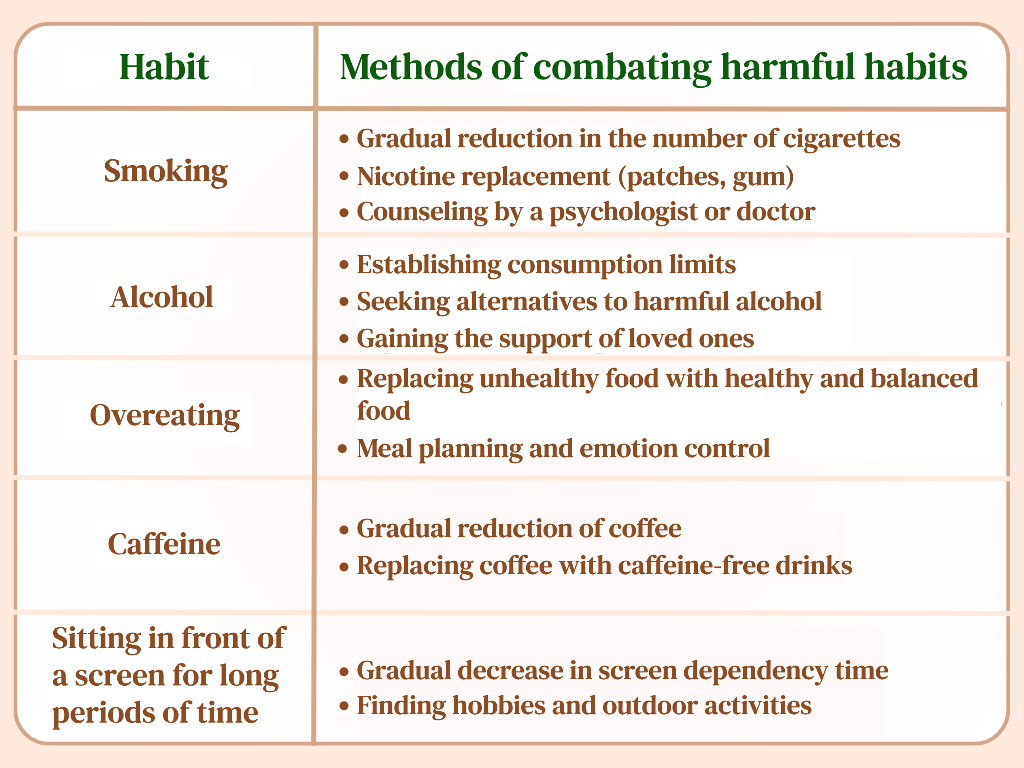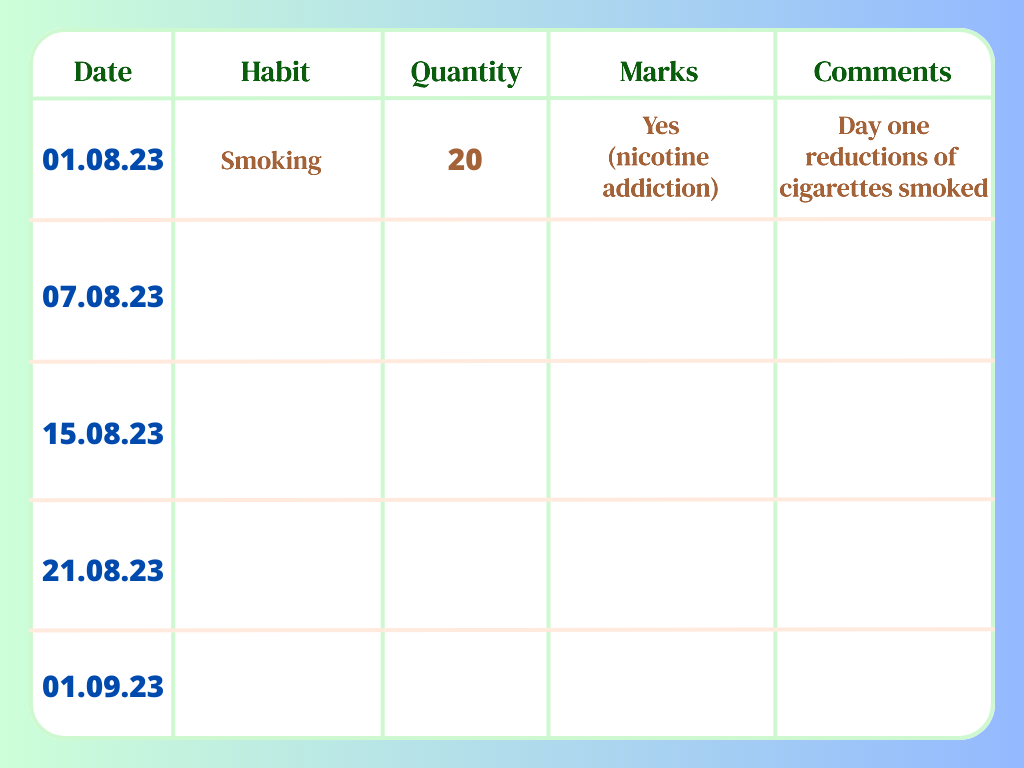How to Get Rid of Bad Habits: Methods and Advice

If you know something is harmful to you, why is it so hard to just give it up? Most smokers, as well as people suffering from alcohol or drug addiction, admit they would like to rid themselves of this detrimental habit. However, only a few succeed, as habits prove to be stronger than new intentions.
Harmful habits not only damage our body, but also destroy families and friendships. Therefore, it’s important to learn how to overcome the barrier between a harmful habit and a healthy lifestyle.
In this article, we’ll explore why getting rid of bad habits is a challenging process and offer a strategy to overcome this obstacle.
How habits work and why we are prone to bad habits
Scientists around the world have dedicated their research to the study of bad habits. They’ve deeply analyzed the processes occurring in our brain during habit formation and, as a result, discovered keys to why it’s so hard to break them.
Research conducted by neurobiologists at the Massachusetts Institute of Technology shed light on an interesting fact: a small part of the prefrontal cortex of the brain, responsible for deliberation and planning, plays a key role in controlling the moment-to-moment activation of habits.
When we form a habit, this area of the prefrontal cortex memorizes the sequence of actions and links it to a certain stimulus or context. This allows our brain to automate certain behaviors, saving energy and resources since we no longer spend time contemplating every minor action.
However, when a habit becomes harmful, such as smoking or excessive consumption of sweets, this automation mechanism becomes a problem. Our brain continues to activate this habit even when we consciously want to get rid of it.
Habits can arise as a result of the activation of the brain’s “reward” centers during pleasant events. This can trigger potentially harmful routines, such as overeating, smoking, drug or alcohol abuse, gambling, and even compulsive use of computers and social networks.
Why it’s hard to quit bad habits
The fundamental mechanisms of forming different types of habits are the same, whether it’s a habit of overeating or following the same route to work. They are based on the same brain mechanisms.
However, it’s important to remember that pleasure-related habits are much harder to break. Pleasurable behavior can lead to the release of a chemical called dopamine. If you do something over and over again, and dopamine is present during it, this further strengthens the habit. When you abstain from this behavior, dopamine creates a desire to repeat it.
This explains why some people crave drugs, even if the drug no longer brings special joy after consumption.
How to overcome bad habits
The good news is that humans are not just creatures of habit. We have many more areas of the brain that help us do what’s better for our health.
Research by Roy Baumeister on decision-making and willpower led him to conclude that “self-control, like a muscle, tires when you exercise it.”
Baumeister’s research shows that successfully resisting temptation temporarily depletes willpower, making it difficult to remain resilient next time. Recent studies also indicate that regular practice of various forms of self-control contributes to strengthening resolve.
“We found that you can improve your self-control by exercising it over time,” says Baumeister. “Any regular self-control action gradually strengthens your ‘muscle’ and makes you stronger.”
Focus on the awareness of your bad habits
One approach to breaking bad habits is to focus on becoming more aware of your unhealthy habits and then developing strategies to overcome them. This approach requires a thorough analysis of all aspects of bad habits. It’s important to consider all factors contributing to the emergence of bad habits throughout the day.
For instance, habits may be associated in our minds with certain places and activities. You can develop a plan to avoid walking down the hallway where the candy machine is located. Set a goal not to go to places where you usually smoke. Avoid friends and situations associated with problematic drinking or drug use.
Identify triggers of bad habits
Triggers play a crucial role in the development of habits. Tracking the triggers that cause habitual behavior is the first step to overcoming that habit.
Spend a few days tracking how your habit manifests.
Pay attention to things like:
- Where does the habitual behavior occur?
- What time of day?
- What are you feeling when it happens?
- Are other people involved?
- Does it happen immediately after something else?
For example, if you want to stop staying up past midnight, by tracking your behavior for a few days, you might realize that you tend to go to bed later if you start watching TV or socializing with friends after dinner. But you go to bed earlier if you read or take a walk.
Find reasons why you want to quit a harmful habit
You need to understand why you want to quit a particular habit. Until you find enough reasons to quit, your brain will resist your desire. List each harmful habit and the negative consequences it may have in your life.
Quitting a harmful habit is not just about avoiding negative consequences, but also about gaining new positive changes in life. Write down all the positive changes you can experience. For example, if you smoke, after quitting you may experience the following positive changes:
- No shortness of breath: You’ll notice that after quitting smoking, your breathing function will improve, and you’ll feel more alert and energetic.
- Greater endurance: Sports, active recreation, and daily tasks will no longer cause as much fatigue as before.
- Improved blood quality: The level of oxygen in your blood will increase, and the content of harmful substances will decrease, positively affecting your overall health.
- Sense of taste and smell: Tastes and smells will become more vivid and intense after quitting smoking.
- Improved skin condition: Your skin will become more moisturized and elastic, and fine wrinkles may smooth out.
- Saved money: Smoking is quite an expensive pleasure, quitting it will allow you to save a significant amount of money.
- Better relationships and social environment: By quitting smoking, you’ll protect your loved ones from harmful smoke and create a more comfortable atmosphere around you.
- Increased self-esteem: Overcoming a harmful habit will be a testament to your willpower and ability to overcome difficulties.
- Improved immune system: Your body will become more resistant to infections and diseases.
- Brighter future perspective: Freeing yourself from smoking will give you the opportunity to enjoy a healthy and fulfilling life without harmful dependencies.
Imagine yourself in a tempting situation
Since the brain continuously forms attachments to habits, we can visualize tempting situations and deal with them in our minds. Train yourself mentally every day to resist harmful habits in various situations. For the brain, an imagined situation is the same as a real one. Therefore, after a few weeks, your connection to the harmful habit will weaken.
Actively replace bad habits with new, healthy ones
One way to get rid of bad habits is to actively replace unhealthy routines with new, beneficial ones. Some people find the opportunity to replace a bad habit, even if it’s drug addiction, with other behaviors, such as sports activities.
Replacing a negative habit with a positive one helps the brain switch to new, more constructive behavior. When you engage in physical activity, your brain produces endorphins — natural “happiness hormones.” This creates pleasant sensations and can replace the pleasure previously associated with the harmful habit.
Apart from sports, there are other ways to replace negative habits. For example, you can engage in creative activities, reading, learning new skills, or interacting with friends who support your choice to get rid of bad habits.
However, remember that replacing habits can be challenging. Some moments may be difficult, and you may face the temptation to return to old habits. It is important to be patient and persistent. As you continue to replace negative habits with positive ones, your brain will adapt to new pathways, and eventually, a healthy and beneficial habit will form.
Use the “Atomic habits” method
Even small changes can lead to grand results. There is a strategy based on the philosophy of seeking opportunities in minimal improvements in everything we do. And even if the result increases by only 1%, a multitude of such small changes in the long term can lead to significant changes.
The “Atomic Habits” method suggests that small changes in behavior can lead to big results in the future. It includes four steps:
- Defining the desired outcome.
- Breaking it down into small tasks.
- Creating a system that allows you to perform these tasks regularly.
- Continuously improving the system.
Useful charts for tracking progress in overcoming bad habits
Tracking progress in quitting bad habits plays a key role in achieving goals and adopting a healthy lifestyle. However, without a systematic approach and control, the process can become more complicated and prone to failure. This is where useful charts come in handy, allowing you to visually track your successes in overcoming habits that prevent you from living your best life.
Chart “Methods for fighting bad habits”
This chart is necessary to keep track of methods for fighting bad habits. Write in the chart the harmful habits and methods of fighting them that are right for you.

Chart “Progress in overcoming bad habits”
This chart will be useful for anyone who is trying to get rid of a harmful habit. In it, you can conveniently track your progress and changes related to your harmful habit.

Record in the chart the number of times you relapsed and practiced the detrimental habit, and add comments explaining the reasons for this behavior. Over time, maintaining such a chart will help you become aware of your harmful habit and significantly reduce its manifestations.
